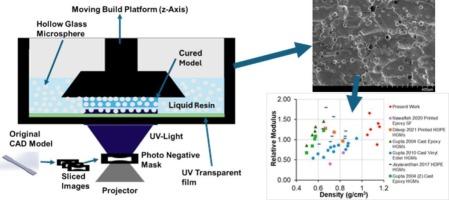Rheology guided additive manufacturing of thermosetting syntactic foams: mechanical behavior and failure mechanisms
IF 8.1
2区 材料科学
Q1 ENGINEERING, MANUFACTURING
Composites Part A: Applied Science and Manufacturing
Pub Date : 2025-08-15
DOI:10.1016/j.compositesa.2025.109248
引用次数: 0
Abstract
Hollow glass microspheres (HGMs) are reinforced in an acrylate-based photopolymer resin to develop a digital light processing based additive manufacturing (AM) method for fabricating composites called syntactic foams. Extrusion based AM methods have been developed for thermoplastic syntactic foams, but inherent challenges have prevented researchers from making progress in developing AM methods for thermosetting resin matrix syntactic foams. Rheological analysis guided the optimal printing temperatures to maintain flow consistency across mixture compositions during manufacturing. Stirring the mixture during printing proved essential for mitigating particle flotation, which is a major issue in syntactic foam manufacturing due to the density difference between particles and the matrix. Mechanical testing revealed that compressive performance benefited significantly from in-situ mixing, with compressive modulus increasing with HGM volume fraction. Micro-computed tomography confirmed particle distribution and porosity trends, while microscopy illustrated the transition from matrix-dominated to particle-dominated fracture behavior with increasing filler content.

流变学指导下热固性复合泡沫的增材制造:力学行为和失效机制
空心玻璃微球(hgm)在丙烯酸酯基光聚合物树脂中增强,以开发一种基于数字光处理的增材制造(AM)方法,用于制造称为合成泡沫的复合材料。基于挤出的增材制造方法已被开发用于热塑性复合泡沫,但固有的挑战阻碍了研究人员在热固性树脂基复合泡沫的增材制造方法方面取得进展。流变分析指导了最佳印刷温度,以在制造过程中保持混合物成分的流动一致性。在打印过程中搅拌混合物对于减轻颗粒浮选是必不可少的,这是合成泡沫制造中的一个主要问题,因为颗粒和基质之间的密度差异。力学试验表明,原位搅拌显著提高了抗压性能,压缩模量随HGM体积分数的增加而增加。显微计算机断层扫描证实了颗粒分布和孔隙率的变化趋势,而显微成像则表明,随着填料含量的增加,裂缝行为从基质为主转变为颗粒为主。
本文章由计算机程序翻译,如有差异,请以英文原文为准。
求助全文
约1分钟内获得全文
求助全文
来源期刊

Composites Part A: Applied Science and Manufacturing
工程技术-材料科学:复合
CiteScore
15.20
自引率
5.70%
发文量
492
审稿时长
30 days
期刊介绍:
Composites Part A: Applied Science and Manufacturing is a comprehensive journal that publishes original research papers, review articles, case studies, short communications, and letters covering various aspects of composite materials science and technology. This includes fibrous and particulate reinforcements in polymeric, metallic, and ceramic matrices, as well as 'natural' composites like wood and biological materials. The journal addresses topics such as properties, design, and manufacture of reinforcing fibers and particles, novel architectures and concepts, multifunctional composites, advancements in fabrication and processing, manufacturing science, process modeling, experimental mechanics, microstructural characterization, interfaces, prediction and measurement of mechanical, physical, and chemical behavior, and performance in service. Additionally, articles on economic and commercial aspects, design, and case studies are welcomed. All submissions undergo rigorous peer review to ensure they contribute significantly and innovatively, maintaining high standards for content and presentation. The editorial team aims to expedite the review process for prompt publication.
 求助内容:
求助内容: 应助结果提醒方式:
应助结果提醒方式:


